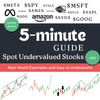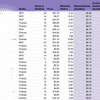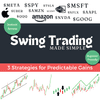
📊 Unlock Powerful Stock Charts!
Get real-time data, custom indicators, and in-depth stock analysis with TradingView.
Try TradingView FreeGross Margin - This One Metric Can Make or Break a Business — Here's Why
Thu, Jun 5, 2025
Table of Contents
Imagine you're running a candle business from home. you spend about $4 making each candle — wax, jar, label, the whole thing. you sell it for $10.
you're not making $10. you're keeping $6 after covering what it cost you to make it. that leftover $6 is your gross profit.
Now take that $6 and divide it by the $10 selling price. that gives you 0.6, or 60%. that’s your gross margin — how much you keep from every dollar of sales, before rent, salaries, marketing, or anything else shows up.
How do you calculate gross margin
there’s a formula, but it’s super basic:
(revenue - cost of goods sold) / revenue
in other words: how much money you kept after making the product, divided by how much you earned from selling it.
if you're selling t-shirts for $20, and each one costs $8 to make, you’re keeping $12. divide that by $20 and boom — 60% gross margin.
note: gross margin doesn’t include stuff like advertising, admin costs, or shipping. it just covers the basic production costs.
if you want to quickly visualize margin trends across different sectors, tradingview is a solid place to start.
Why do investors care about gross margin
it gives you a quick read on how a business runs under the hood. like, does this company actually keep much of what it earns, or does most of it go right back out the door?
take apple ($AAPL). an iphone sells for around $999. manufacturing it costs somewhere near $450–500. so apple's gross margin on that is around 50%. they keep half. that’s strong.
now look at amazon ($AMZN). it moves a ton of product, but gross margin is often around 13–15%. it’s a thinner model. more moving parts. more logistics. less margin.
so when you’re investing, you’re not just looking at how much money a company brings in — you’re looking at how much they actually hold onto from each sale.
if you're new to investing, robinhood or m1 finance can be simple platforms to explore and compare company fundamentals.
What's considered a good gross margin
depends on the business. not all industries run the same.
retail businesses might be happy with 30%. restaurants might have to survive on 10–15%. software companies? they’re often way up at 70–80% because the cost to deliver one more unit is basically nothing.
so there’s no one “good” number. what matters is whether the margin is stable, trending up, or slowly getting squeezed.
if you're tracking these numbers across multiple holdings, a free tool like personal capital can help you see how your portfolio companies compare.
Is high revenue the same as high profit
nope.
a company can sell millions worth of stuff and still lose money if their costs are too high. high revenue doesn’t mean much if most of it is going out the back door.
if something sells for $100 and costs $95 to make, the margin is just 5%. that barely covers anything. there’s not much breathing room there.
What gross margin doesn't tell you
Gross margin only looks at the cost of making the product or delivering the service. it doesn’t include:
- team salaries
- rent
- marketing spend
- software tools
- delivery fees
- taxes, interest, or anything else operational
so it’s not the full picture. but it’s one of the first pieces of the puzzle.
How to use gross margin when researching a company
when you're looking at a stock, checking gross margin helps you figure out what kind of business it is. is it built on volume? or is it built on keeping a larger slice per sale?
check if gross margins have been holding steady over time. if they’ve been falling, it could mean prices are dropping or costs are rising.
also compare companies in the same industry. for example, microsoft ($MSFT) might have different gross margins across cloud, gaming, and hardware. looking at the total number doesn’t always tell the full story — sometimes you have to zoom in.
if a business can hold strong margins while scaling, that usually says something good about their pricing power or efficiency.
you can scan margin data quickly using a tradingview screener to compare dozens of stocks at once.
So what should you take away from all this
gross margin is just a first filter. it doesn’t tell you if the business is profitable overall, but it tells you how much they keep right after delivering what they sell.
if you’re running your own business, it helps you figure out how efficient your model is. if you’re investing, it gives you a clue about the company’s pricing strength, production costs, and overall setup.
it’s not the final answer. but it’s a smart place to start.
and once you’ve looked at gross margin, the next step is checking where the rest of the money goes — ops, marketing, r&d, taxes. follow the trail.
Not financial advice, just sharing my thoughts!
Related Posts
Free Cash Flow - This One Number Reveals What a Company Really Makes
Fri, Jun 6, 2025
Learn what free cash flow really means, how to calculate it, and why it matters more than revenue in stock analysis.
Don’t Buy Another Stock Until You Understand Debt/Equity Ratios
Wed, May 28, 2025
Learn how to use the debt/equity ratio to assess a company’s risk, spot red flags, and make smarter investing decisions—without the finance jargon.
🌟 Buy Me Coffee
Love the market insights, stock analyses, and investing tips I share? Help me do more by buying me coffee. Your support funds deeper research, keeps content ad-free, and helps create more tools and resources for the community.


